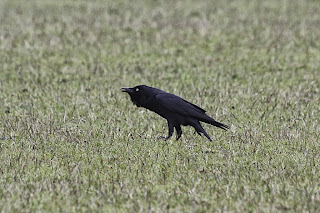I thought my Eaglehawk Pelagic blogs need a prologue so ...
After the official reports of the trips on September 14th
and 15th came out, twelve pelagic fanatics who had missed out got
together and booked the boat for last weekend, the 21st and 22nd. As it turned out though it seems our weekend had been an eruption of birds and
the event had subsided or passed on. While the trips on the 21st and
22nd had similar variety as normal (30 species) it sadly did not
match the previous weekend for the quantity of birds seen nor the number of “special species”. That
weekend of the 14th and15th is now starting to be called “the most
spectacular pelagic in southern Australian waters ever”.
The final list of 35 species for the 14th/15th
weekend is:
Southern Royal Albatross; Northern Royal Albatross
Wandering (Snowy) Albatross; Antipodean (New Zealand) Albatross
Black-browed Albatross; Campbell Albatross;
Shy Albatross; Indian
Yellow-nosed Albatross; Grey-headed Albatross
Light-mantled Albatross; Sooty Albatross
Grey-backed Storm-Petrel
Fairy Prion;
Antarctic Prion; Salvin’s
Prion; Slender-billed Prion
Short-tailed Shearwater; Sooty Shearwater
Northern Giant Petrel; Southern Giant Petrel
Common Diving Petrel
Great-winged Petrel – gouldi
and macroptera; White-headed Petrel; Soft-plumaged Petrel; Blue Petrel; Grey Petrel; White-chinned Petrel; Cape Petrel;
Little Penguin
Australasian Gannet;
Black-faced Cormorant;
Crested Tern; White-fronted
Tern; Pacific Gull; Kelp Gull; Silver Gull.
After the 14th/ 15th pelagic Marlene and I stayed on at the Lufra so we
could go birding on the Monday and when I woke up and looked out the window I
saw how lucky we had been with the weekend weather. A mix of low cloud and rain
cut visibility so I couldn’t see across Pirates Bay and the wind was strong
from the north-east. The day was not at all pleasant so we had a leisurely
breakfast in the dining room and gazed out at the drab, grey scenery, then had another cup of tea.
The Lufra I should mention is an Art-Deco hotel built in the 1930s and it still
retains some of the charm and ornamentation of that period so it is a wonderful
place to stay, and the food is very good. The wood fire in the lounge makes it a very pleasant place to sit with a drink after a hard day's pelagic birding.
 |
| Two skinks sunning on a forest log |
Our land birding actually started on the Saturday night when a group of us went to see the local Masked Owl. Then on the Sunday night Marlene and I set out on another owl-prowl hoping to find a Morepork, a task at which we sadly failed. At one point a Tawny Frogmouth flew over the car but that was all the bird life we saw.
I did learn the excitement of driving at night on Tasmanian
country roads though. Small mammals and marsupials were everywhere. Eastern
Barred Bandicoots scuttled off the edge of the road as we approached and
Brush-tailed Possums just sat and watched. Small wallabies (Red-bellied
Pademelon) also sat and watched as we went by but Potoroos, small marsupials related to the wallabies and the size and shape of a brown bouncing basket ball covered in fur, had a death wish. As we
drove the night roads these small dark brown fur balls would explode unseen from the side
of the road with the speed of a startled Ferrari and cross in the headlight beam
a metre or less in front us (well, maybe 5 metres), and be off the other side
of the road before our car could travel that one metre that would have proven
fatal. However, judging by the number of road kills we saw much of the Tasmanian fauna is, sadly, very bad at estimating the speed of approaching cars.
 |
| Shearing shed with Merino rams in the foreground. Piles of sheep pellets can be seen under the shed. |
Of course Tasmanian roads are all single lane; well that’s how they felt as on-coming cars did their best to remove the side mirror and peel a layer of paint from our diminutive hire car. Scary stuff. The narrow winding roads also make birding difficult because, when a new bird is seen and the brakes go on, it is hard to get the car far enough off the road to allow other cars to pass. But we survived and duly spent a wet and windy Monday looking for little brown birds in the dripping forests. Of course all birding is good birding so we had a fun day with plenty of birds showing off for us. On getting home I even found out that the Olive Whistler in Tasmania is a different race to the Victorian one so I got a ticklette – as everyone knows a “tick” is when you see a new species but for those who haven’t yet heard about “ticklettes”, they are what you get when you see a new race of a previously seen species.
 |
| Flame Robin. First you catch your caterpillar ... |
 |
| ... then you beat it on the log until caterpillar juice comes out and it is dead. |
 |
| Tasmanian Scrubwren. |
 |
| Tasmanian Thornbill showing its tuft of white feathers at the vent. |
 |
| Olive Whistler being a "skulker" in the thick undergrowth. |
 |
| Yellow Wattlebird. |
 |
| Masked Lapwing chick with a buzz of feathers around a very skinny neck |
 |
| Forest Raven |
 |
| Tasmanian Native-hen |
I ended the Eaglehawk weekend with 58 species of non-pelagic birds, the best being the Masked Owl.
My bird of the weekend though has to go to the Grey-headed Albatross because this species is uncommon in Australian waters and I got only my second, and best ever, view.

A nice selection of Tasmanian birds.
ReplyDelete"Ticklette" I love it ! :)
ReplyDelete